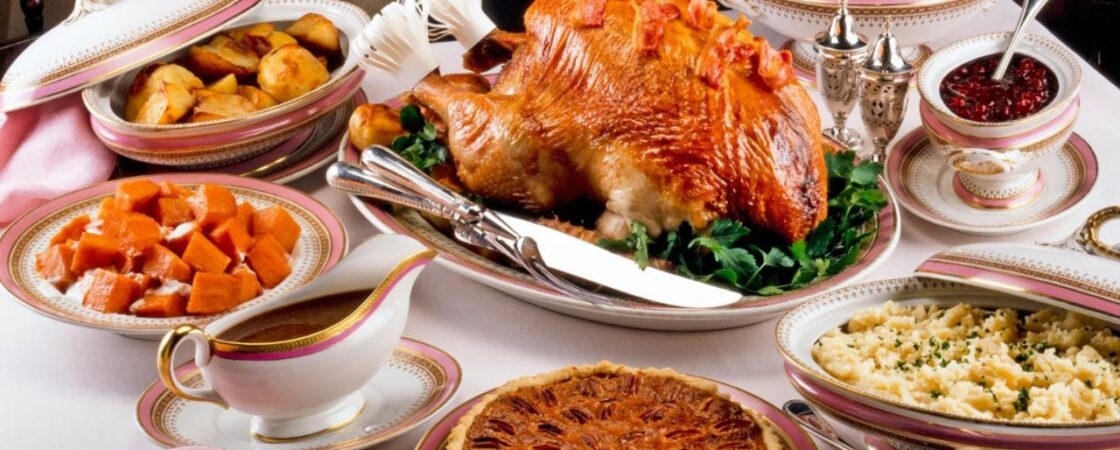Most Thanksgiving meals across the United States omit venison, eel, and corn porridge. Yet these edibles are widely believed to have occupied the table at the “first Thanksgiving” at Plymouth Colony, Massachusetts in 1621. Of course, other locales claim to have originated the celebration of gratitude, among them Jamestown, Virginia and York, Pennsylvania. Still, what was eaten the first time — regardless of geography — diverges from the foods most know, love and associate with the holiday. These traditional victuals have universal appeal and are often supplemented with dishes linked with ethnicity and other family favorites.
You know the most commonly beloved foods associated with this uniquely American harvest festival:
- Turkey
- Yams
- Mashed potatoes
- Root vegetables
- Pumpkin pie (any pie, actually!)
Selecting a Turkey Recipe
The turkey is the centerpiece of the Thanksgiving table. However, this fowl is not a universally loved food, and often eaten once a year out of custom and obligation. Holiday hosts do well to employ the best turkey recipe they can find. The good news is that there is no shortage of turkey recipes. Each varies in the manner of preparation and cooking; the seasoning; and the composition of the dressing.
The Raw Truth on Cooking the Bird
Perhaps the biggest fear of turkey preparers is that the bird will end up dry. Those who prefer the turkey roasted are particularly beset by this worry since the turkey does not carry a lot of fat. The solution, in most cases, is, well, a solution. Brine is a simple solution of salt in water. Submerging the bird in a brine for 12 hours before sticking it in the oven goes a long way to infuse moisture and flavor. Doing so also breaks down proteins, rendering the meat more tender.
Experts at turkey preparation stress a few rules of thumb for the best turkey recipe:
- Preheat the oven to 450 degrees Fahrenheit, dropping the temperature to 350 when the bird goes in.
- Assume 13 minutes of roasting time per pound, more or less. If the turkey is stuffed, up that to 15 minutes per pound.
- Check the internal temperature at the thigh — 165 degrees signifies doneness.
- Let the main course cool for at least 20 minutes before attempting to carve.
All Dressed Up
Stuffing, or dressing, can not be separated from the absolute best turkey recipe. It is the ultimate side dish but, in many ways, it is essential to the main dish. This goes to the question of whether or not the stuffing should be stuffed, on the one hand, or cooked separately from the bird. The Food Network recommends cooking the stuffing first and then placing it inside the turkey. Of course, the components of the dressing have much to do with this decision. A traditional bread stuffing, made with white bread cubes, sage, herbs and chopped vegetables, cooks just fine inside the turkey cavity. A more complex dressing — with sausage or bacon, for example — is worth pre-cooking before insertion. Either way, the absolute best turkey recipe needs a flavorful and well-textured stuffing to be complete.
Eats Roots, Shoots and Leaves
Certain vegetable dishes are most often linked to America’s autumnal celebration of thanks. Sweet potatoes (actually yams), glazed carrots, green bean casseroles, parsnips, mashed potatoes, brussel sprouts and myriad root vegetables. The wonderful thing about veggies is that you can employ alternatives to these and still adhere to tradition. Chopping up carrots and brussel sprouts; adding cranberries and pecans; then marinating them in balsamic vinegar prior to roasting at 400 degrees Fahrenheit yields a delectable vegetable medley that goes beyond boiling them, as the Pilgrim forebears likely did. Another twist could be to forgo the marshmallow topping and saute sliced yams in butter, brown sugar and bourbon (alcohol cooks out) for 10 minutes before baking them for ninety minutes at 400 degrees.
More than Just Pie
While turkey is the centerpiece of the feast, dessert is the destination, that which is eagerly awaited by anyone with taste buds. Traditionally, pies have constituted most Thanksgiving dessert menus — pumpkin, mince, apple, blueberry etc. At the same time, the sweet treat at the meal’s end does not necessarily come in a crust. Even ardent traditionalists would not object to bread pudding, apple cobbler and fruit tart recipes that combine novelty with comfort food. After all, variety is not only the spice of life, it is also the best virtue of a traditional Thanksgiving dinner. For tasty Thanksgiving desserts, click here.




